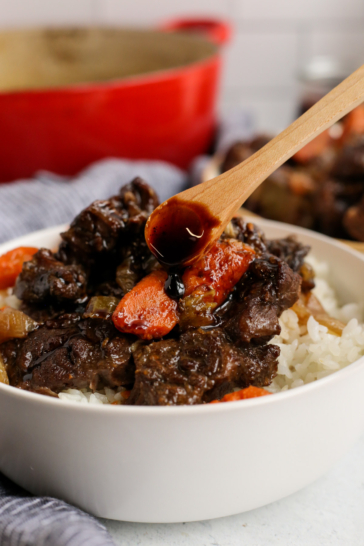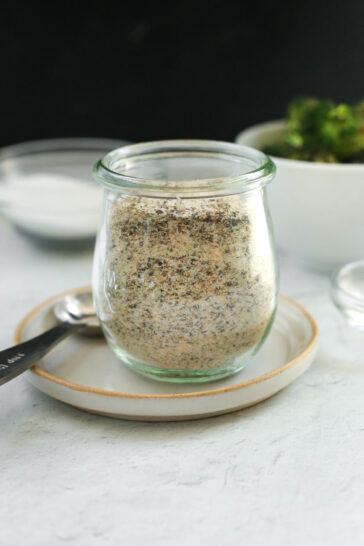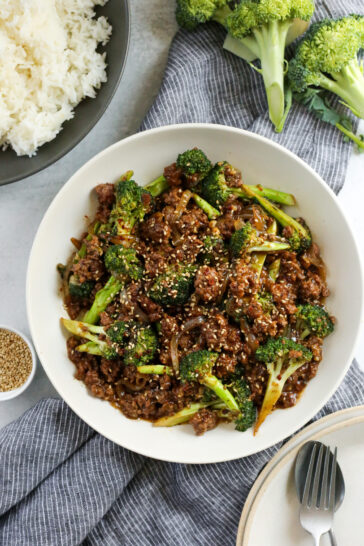If you’ve ever wondered if fresh fruit is safe to eat, keep reading! Learn more about pesticide residues on fruit and what it takes to grow apples, pears, and blueberries. When it comes to enjoying fruit you can let facts, not fear, be your guide.
Have you ever visited an apple orchard? What about blueberries or pears? It’s rare to see firsthand where our food comes from. So when I was invited to join a media tour for dietitians in the Pacific Northwest in September, I jumped at the opportunity!
Now I’m sharing what I learned from the farmers while I was there!
Disclosure: I was an invited guest on the “Facts, Not Fear” farm tour which was paid for by the Alliance for Food & Farming. I was compensated for my time to write this blog post, but as always, all opinions are my own.
As a registered dietitian, I notice many of my clients feel afraid or hesitant about eating fresh produce. This seems to be especially true if they’re worried about conventional compared to organic fruits and vegetables. And I understand the concern. After all, for years we’ve been hearing about “The Dirty Dozen” and “Clean Fifteen” lists. It’s scared a lot of people away from eating non-organic produce.
Since this fear of pesticides has been pounded into us, it’s no wonder we might steer clear of fresh fruit in the grocery store if it’s not organic! But after seeing the hard work, care, and dedication that goes into growing our food, I feel confident that fresh fruit is indeed safe. Come with me to see why!
The Pacific Northwest “Fruit Loop”
A few years ago I visited the Portland, Oregon area and learned that the area to the east, including Hood River and the Columbia River Gorge, is affectionately and aptly called The Fruit Loop. It’s a scenic loop that’s home to sprawling orchards of apples, pears, cherries, berries, peaches, hazelnuts, and more. There are small towns, fruit stands, wineries, restaurants, and our first destination, Duckwall Fruit.
Mount Adams can be seen clearly from their apple and pear orchards and we were lucky to have perfect weather on the day of our visit. It was also perfectly timed to be able to watch some of their crews harvesting Honeycrisp apples, one of the varieties they grow.
Growing Apples and Pears in the PNW
These orchards are designed to take maximum advantage of the climate, elevation, soil, and sunlight to grow fresh fruit that’s safe to eat. Here’s why:
- Apples need the right combination of cool night temperatures and arid (not humid) days. The elevation in this region can provide both (although the extreme temperatures of two heatwaves took a toll in 2021 and led to much higher losses than usual).
- The three major mountains, Mount Adams, Mount Hood, and Mount Saint Helens contribute both volcanic soils and strong influences on the local weather.
- The climate of the PNW means fewer pest pressures. That means more organic apples are grown here than anywhere else – there’s simply less of a need to spray insecticides, herbicides, or use other crop protection methods when there are fewer threats in the first place.
- And if you look closely, you’ll see reflective strips between the rows of apple trees. These shiny sheets bounce the sunlight back onto the trees, which helps the bottoms and sides of the apples turn red. If you reached for an evenly colored apple or thought it was more ripe than an unevenly colored one, this is why!
This region grows about 90% of all fresh pears in the United States. They also grow 65% of apples and about 90% of all organic apples. But just because more organic apples are grown here doesn’t mean conventional apples are worse. It just means that for other regions of the country to grow apples, they need to use different strategies to get ripe, high-quality fruit to harvest.
Myths About Organic Farming
One of the persistent myths I hear about organic produce is that the “organic” label means it was never sprayed. However, this isn’t always true. There could potentially be a fortunate scenario where growing conditions are so perfect that a farmer would never need to combat weeds, insects, fungus, or other pests. But the reality is that even organic farmers have to contend with these threats to their crops.

Instead of using conventional growing practices or synthetic pesticides, they instead use organic growing practices and naturally produced (non-synthetic) pesticides. And when there isn’t a non-synthetic option available for certain pests, some synthetic pesticides are approved for use in organic operations.
On the other hand, “non-organic” doesn’t mean that spraying pesticides is the only strategy to defend against pests. Take pears, for example. One of the biggest insect issues for pears is a type of psilia fly. Farmers use a non-chemical treatment for pears that involves spraying an organic oil and sulfur mixture onto the trees. Since the flies don’t like to land and lay eggs on an oily surface, the farmers can control the population without spraying insecticides later in the season. Farmers can also release beneficial bugs into their orchards to eat the harmful bugs. Some of the orchard blocks we visited hadn’t been sprayed for over 90 days. That means for the three months prior to harvest, no chemicals (natural or synthetic) were used.
Another myth is that organic growing methods always take less of a toll on the environment. While that might be true in some cases, it doesn’t apply to every farm or crop all the time. That’s because in some cases, such as some of the fruit we saw, it must be sprayed 3-4 times over the course of the season. In comparison, a more effective conventional pesticide might only need to be used once.

Did you know that a lot of farmers grow both organic and conventional crops? Sometimes within just a few acres of each other? Farmers care deeply about their land, their crops, their families and employees, and their financial futures. They’re deeply committed to growing fresh fruit that’s safe to eat because they eat the same fruit we do. Having choices in which growing practices they use can ensure they make the best decisions based on what they need. It also gives us (the people who buy the food they grow) more choices, too.
The Bottom Line: “Organic” refers to growing practices and is often used for marketing. It is not a sign of being nutritionally superior or safer for you or the environment. It just lets you know it was grown using certified organic practices.
What About Pesticide Residues on Fresh Fruit?
If you’re worried about residues from either conventional or organically grown produce, I recommend checking out the Pesticide Residue Calculator. You just enter some basic information and pick the fruit or vegetable you’re eating. It will tell you how many servings of that fruit or vegetable you’d have to eat every day before you’d have to start worrying about pesticide residue risks.
For me, I could safely eat 159 servings of pears every day even if those pears had the highest recorded levels of pesticide residues according to the USDA (United States Department of Agriculture). For apples, that number jumps to 850 servings. And for blueberries, the other fruit we saw on this tour, it’s a staggering 13,225 servings per day! Considering that most Americans don’t eat the recommended 5-9 servings of fruits and veggies each day, it’s pretty unrealistic to think we’d ever get remotely close to a concerning level. In the case of blueberries, I’m not even sure I could eat that many servings in my lifetime!
The USDA regularly tests for pesticide residues through the Pesticide Data Program (PDP). The most recent year we have on file is 2019 and you can access the full report HERE. The randomly collected samples come from both imported and domestic produce. They’re tested for residues from pesticides applied both before and after harvest according to their approved label use.
Nearly 99% of the samples tested were below the tolerances established by the EPA (Environmental Protection Agency). And 42.5% of the samples had no detectable pesticide residues at all. The report also addresses the fact that some detected pesticide residues were present in higher amounts from imported produce than produce grown stateside. Additionally, “tolerance violations” are reported if there are higher amounts of pesticides than what is allowed. This may also get flagged if a residue is detected that has no established tolerance. If this happens, the FDA (Food & Drug Administration) is notified and steps are taken to monitor and follow up before the next harvest.
I know the thought of any pesticide residues whatsoever can make you uncomfortable. And I think it’s wise to keep a questioning mind when we hear information about food or anything else. But I can assure you, the health benefits of eating more fruits and veggies far outweigh any potential risks. The dose makes the poison. But advocacy groups often conveniently leave out this fact when they use negative or fear-based messaging.
The Bottom Line: The presence of a pesticide residue on fresh fruit doesn’t automatically mean it’s risky to eat it. Wash it well under running water, and remember that it’s virtually impossible to eat enough servings to be at risk.
Getting Fresh Fruit from the PNW to You
Once harvested, pears and apples are transported to Mount Adams Fruit. As a packer, their role is to sort, pack, store, and ship fruit destined for your grocery store. About 30% of what they pack is exported, mostly to Mexican, Canadian, or Asian markets. People all over the world enjoy eating fresh fruit year-round. Cold storage and other technologies help extend the shelf-life and durability of these fruits. This ensures they get there without sacrificing quality, safety, or flavor.

I’ve heard from several people that they don’t trust non-organic fresh fruit because they think it’s “tampered” with. But after touring the entire packing facility, my mind was put at ease that there’s no tampering happening to our fresh fruit after it’s harvested.
The process doesn’t change regardless of whether they’re packing organic or non-organic fruit. The pears you see pictured above were unloaded from trucks, then the bins were turned out into a pool of water. This allows the ripe pears to float while sticks, leaves, and other debris sinks. After moving through a high-speed camera that quickly determines the shape and size of the pear, they’re sorted in these automated lanes that drop them onto the correct belt to move to the packing process.
Street Smart Nutrition Tip: There were many Covid-19 safety precautions and policies in all of the facilities and farms we visited. If you’re curious about how to safely wash and store produce, check out this post Safe at Home: Best Practices for Shopping, Storing, and Cooking.
Cold storage is also extremely important. While visiting the blueberry farm on the second day of the tour, we learned about the cold chain. This refers to the cooler, chilled temperatures the berries are stored at. This can inhibit mold growth, preserve the flavor and freshness, and help them arrive in your grocery store in optimal condition. But if the cold chain “breaks”, meaning the berries came out of refrigeration and started to warm up, condensation forms. It’s like when a glass of ice water sits out on a hot day. That moisture gives mold an opportunity to grow. So if you ever see mold on a berry after you’ve bought it, just know it’s not a safety issue from the farm. It has more to do with the challenges of maintaining consistent refrigeration during transport and sale.

I thought it was pretty incredible to see the speed and efficiency of everything in this process. The fruit moves from the orchards to the packing facility within a few hours. It may be held in refrigerated, climate-controlled rooms before sorting and packing. But once that process starts it moves through in just a matter of minutes. Once it’s packed, it’s ready to be shipped to retailers and grocery stores or foodservice, like restaurants, hospitals, or schools. There is a detailed tracking system for each step, using bar codes, QR codes, and other identifiers. This allows for tracking of specific details like:
- The orchard block it was picked from
- The farmworker who did the harvesting
- The time and date it was picked, packed, and delivered
- The farm it came from and exactly when and how pesticides were applied, and of course which ones were used
If or when there’s ever a question about the safety or quality of the fruit, it can be traced back to the source. The fresh fruit industry is using technology and other innovations to produce food that is safe and delicious.
I think it can be intimidating to imagine how much technology is associated with what we eat. But I also think it’s important to remember there’s a reason why things are done the way they are. It’s expensive and difficult to grow food with a lot of risks involved. For every dollar spent at the grocery store, only about 19 cents comes back to the farmer. There’s no incentive for them to waste money or effort on practices that would jeopardize the safety or quality of the food they grow.
The harvest season can last about 60 days, depending on the fruit and where it’s being picked. It’s an incredibly busy time of the year. I was very thankful for the chance to visit these farms and see this process with my own eyes. It makes me feel much more confident in the safety of the food I eat. Pesticide residues on fruit are no longer something I feel like I need to worry about. And I sincerely hope it can put your mind at ease if you had questions or concerns, too.
Thank you for reading, and I hope you can enjoy some fresh fruit today!
About the Alliance for Food & Farming
The Alliance for Food & Farming is a non-profit organization that represents both conventional and organic farmers, with operations large and small, across the United States. The Alliance was formed in 1989. It exists to deliver credible information to consumers about the safety of fruits and vegetables. Today, they have a staff of two and are funded exclusively by voluntary contributions from producers and companies that work directly in or alongside the produce industry. Among their various advocacy and communication activities is the Safe Fruits and Veggies website, which is home to the Pesticide Residue Calculator mentioned above.
And if you’re interested in more Facts vs. Myths about fruit, check out this post looking at 100% orange juice!



















